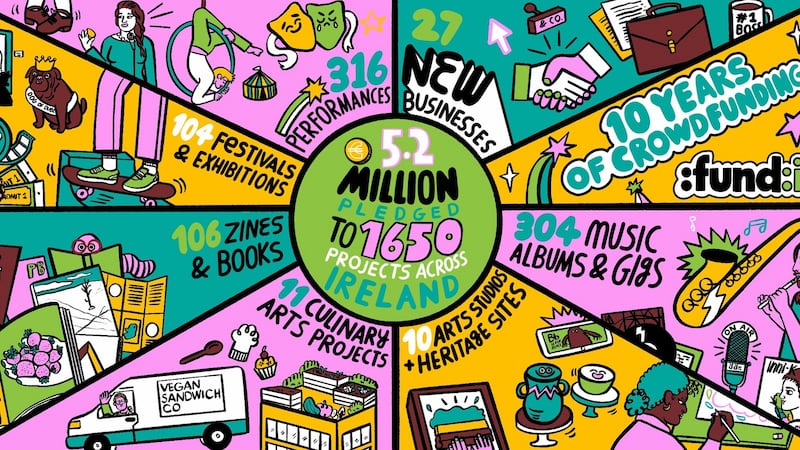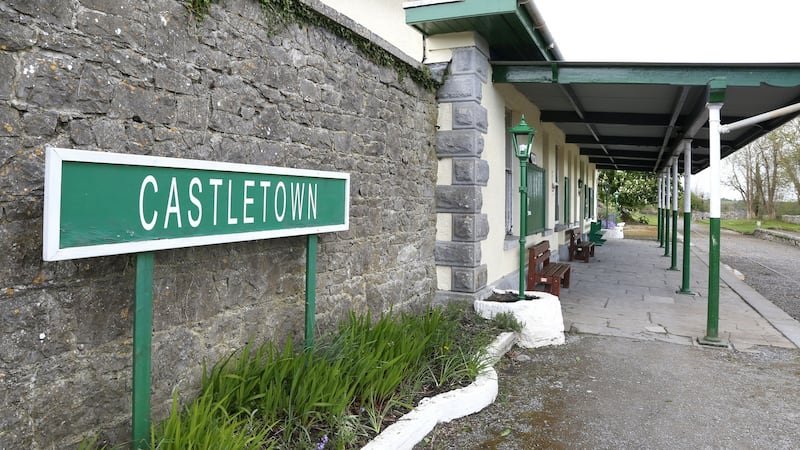“Someone bought the chicken for life, so that means I’ll be naming one of my chickens after a kind funder. We still have the sourdough, and the holy shrine available!” Musician Max Zaska is talking about some of the quirky rewards he’s offering for those who help fund his second neo-soul/funk album, A Better Way, promising “face-melting, stanky grooves”.
As we chat early this month, guitarist-composer Zaska is in the throes of his Fund It campaign, with 12 days to run aiming to raise €16,000. The campaign takes up most of his time. “We’re almost there. It’s definitely all consuming for however long your campaign is. It’s pretty full-on for a month, but if you can get a good chunk of money for your art, then it’s definitely worth it.”
Aside from more modest rewards, the Chicken for Life for a €2,500 donation involves naming rights for a chicken, plus updates and pictures: “Your own pet chicken without any of the hassle.” For €5,000, Zaska, a certified sourdough master, promises the secrets of sourdough and the equipment to make it, while he’d make “a Holy Shrine of Stank in my cabin studio” in thanks for €10,000.
Putting together a reward scheme is one of the jobs in what is a full-on crowdfunding experience of a Fund It campaign.
The first reward-based crowdfunding site set up in Ireland, Fund It marks its 10th birthday this month. Andrew Hetherington, chief executive of Business to Arts, which brokers creative partnerships between businesses and the arts, cofounded Fund It in 2011, having seen the model working in the US. “Reward-based” is the key term here: rather than generalised pledges, this crowdfunding model sees individuals donating to a specific project and getting a non-financial reward.

Fund It’s speciality is raising money digitally for creative projects, covering a wide spectrum – art, craft, design, events, fashion, film, TV, food, games, media, publishing, music, performance, science, technology, heritage, entrepreneurship. Pledging modest but meaningful amounts of money to artists and creatives via crowdfunding campaigns is one way people can support the arts during the pandemic, says Hetherington.
Over the decade Fund It has raised €5.2 million for 1,200 Irish projects, mostly from relatively modest donations – from €5 to more than €5,000 – pledged by people around the world.
Take Daragh Muldowney, a fine art photographer who’s travelled to Lake Baikal in Siberia over three years, working on Beacons, a fine art photobook and limited edition prints. Following two Fund Its for pre-sales of previous books, Out of Thin Air and Jewellery Box, last year he set a target of €21,500 for Beacons (and hit €25,800). Between three campaigns he’s raised €59,887 from 550 small donors.

Piano virtuoso Úna Keane has raised €17,460 via three Fund Its, to produce albums of her minimalist music. Her live Collaborations was recorded at Dublin’s Pepper Canister Church last March (one of the few live albums recorded anywhere last year), and she crowdfunded in December for €3,015 to press the album to vinyl and CD. Meantime, over four albums since 2011, Cork singer-songwriter John Blek – crossing classic Americana with US folk – raised €17,567 from 421 funders in four Fund Its.
“People want to support the arts at the moment,” says Hetherington. “Some people may think doing that is out of their price bracket. But crowdfunding is a way to support artists, locally or in the wider community. Projects have benefitted from digital campaigns on our website, with donations of very modest amounts. The average donation is €55, so it’s relatively affordable. It also gives people a connection with a project they’re interested in, or an artist whose work they like – watching a play take shape, or getting something at the end, an invitation or a book or whatever.”
He gives the example of Poetry Bus magazine, a small operation run by Collette and Peadar O’Donoghue in Wicklow, who have used Fund It to help produce Poetry Bus’s curated poetry and illustration, and quality chapbooks known as Grimoires. With nine Fund It campaigns in 10 years since 2011, raising from €600 to €3,000 (totalling €12,301 from 492 funders), this is Fund It’s top repeat project, “and no failures yet”.
For the O’Donoghues, it’s a convenient and easy-to-use way to pre-sell their literary projects. Latest was last year’s PB9 (The Covid Diaries), a collection of poems from a broad spectrum of poets, written during lockdown (targeting €600, it reached €740).
Crowdfunding like this often suits the early stages of a project, says Hetherington. Greywood Arts Centre last year raised €15,885 to kickstart an ambitious plan for a rural arts centre in Killeagh village, east Cork. That money went towards its new roof, starting a €365,000 project also drawing funding from Leader, Cork County Council, a charitable trust. Greywood was the fourth top grossing Fund It project in 2020, coming after Cork musician John Spillane (raising €26,884), Muldowney’s €25,800, and the Limerick’s Hunt Museum (€17,760).
In 2017 another unusual heritage building campaign was Save The Quiet Man train station at Ballyglunin in Co Galway. With a €30,000 goal for a roof facing collapse, they raised €32,444 from 454 donors. The Ballyglunin Railway Restoration Project's rewards ranged from lapel pins for €10 donations, to a shrub in your name for €40, to the station as a nifty wedding location for €2,000.

Fundraising is hard work, and doesn't suit everyone
Crowdfunding “provided a solution during the last financial crisis”, when Fund It started, says Hetherington, “and it’s likely digital fundraising will be an increased part of the future as the repercussions of Covid play out in the arts sector.”
It’s a model that suits smaller creative projects, where it’s harder to raise money through traditional funding or grants. Commission fees are 8 per cent, and fundraisers are encouraged to include that and the cost of delivering rewards into the target.
“Fundraising is hard work,” says Hetherington, and doesn’t suit everyone, for example, those who’re not ready for a digital fundraising campaign, engaging with donors online and via social media. But if crowdfunding suits, Fund It boasts a high success rate for reward-based sites – never dipping below 71 per cent of funders reaching their targets, while some larger international crowdfunders’ success rate is 32-46 per cent, he says.
Zaska was confident of hitting his target by deadline; his first campaign went down to the wire and made it with just a day to spare. This is critical because Fund It has an all-or-nothing model, where funders’ cards are debited only if the project reaches its goal; this protects the artist as much as the donor, says Hetherington. It also concentrates the mind, risking losing all you’ve raised, after much effort. Still, says Zaska, “I like that. It’s unique. Also, when you tell someone about the clause, they’re more inclined to Fund It. It’s more of an incentive.”
He wrote the album A Better Way in 2019, and has recorded 75 per cent of it, “some in isolation and some in between lockdowns”, with artists including Tolü Makay, Faye O’Rourke, Jess Kav, Melina Malone, Precious Okpaje, James Smith, Carly Coonagh and a “dream team band”.
This is the last push before release in October-November; oddly, “Covid sped up the process”.
“Last time,” – his first album It Takes a Village was four years ago – “the Fund It covered the recording, and I discovered that releasing it costs a lot of money, so I’ve gone for more this time, to include promoting it properly,” says Zaska. He got a €6,000 Music Industry Stimulus Package grant from the Department of Tourism, Culture, Arts, administered by First Music Contact. It cost about €10,000 to record and pay artists and technicians, and will be another €10k to release – vinyl duplication, photos, merch, promotion. The grant plus crowdfunding €16,000 means “we will pay everyone a proper fee”.
But it’s a lot of work to raise it. “I’ve learned a lot more about self-care since the first time! It was a longer campaign, six weeks. This time it’s going a lot faster, but it’s still the main focus of your day for four weeks” – making contact personally (“it’s very effective”), preparing social media content, updating his email list. “Lots of conversations with people. If you just did social media, it wouldn’t be a very successful campaign.”
Fund It works with crowdfunders before they go live, and backs only campaigns it believes will have an audience, and who they know can deliver the project. “They had some suggestions and helped out getting it off the ground. They know good practice. They told me to edit my video down, it was too long. If I was in trouble with funding, I’m sure they’d come on with ideas. They’re there in the background, a bit of support.”
Crowdfunding is difficult in a pandemic, “but people are lovely, and forthcoming”, says Zaska. “It’s absolutely worth it.”






















